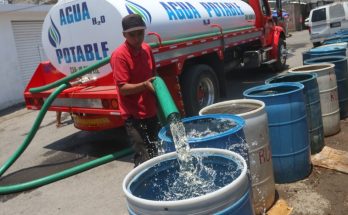By Alejandro Angulo
The previous water shortage that the City of Querétaro suffered—due to damage to the Aqueduct II pipeline—provided several lessons about managing scarcity, and showed us the current face of egotism that today’s society suffers from. According to information released on social media by the Secretary of State Government, Flo Networks was responsible for the problem. In principle, the response time for repairing the damage was not excessive, and the State Government acted responsibly in meting out sanctions to the responsible party for the damage.
There were two mechanisms for alleviating the scarcity of water in homes: the one provided by individuals using water tankers—although the charge per liter was excessive—and the one offered by the State Water Commission (CEA) for free water also delivered by tanker trucks. With respect to these two supply sources, in a future contingency, the State Government must set a maximum price per liter to avoid abuse and speculation. In addition, the CEA must differentiate its charges for those sectors with economic means, and set a voluntary payment in neighborhoods with scarce resources. These resources can be used to obtain a larger fleet of tankers, since the current fleet cannot supply all the neighborhoods.
In neighborhoods with a high socioeconomic level, the discussion about the cause of the damage focused on the economic consequences for the company in question. In middle-class neighborhoods, there was little credibility in the government’s version that the shortage was caused by a company and by the scarcity of water. In working class neighborhoods, the discussion was pragmatic, and revolved around what time and which day the tankers would appear to provide them with water.
Regardless, neither the CEA tankers nor the private ones ever showed a document that guaranteed the drinking quality of the water. There is no doubt it is a human right that providers not take advantage of the situation and sell unsafe water.
It was possible to observe the selfish attitude that prevailed, as whoever drove the CEA tankers or who called the private tankers exercised control over the distribution of water. Consequently, some had all their buckets filled without a care for others not getting a drop. For this reason, in a future contingency the maximum volume per family must be regulated to achieve an equitable distribution. This is part of the human right to a quantity of water based on the average available per inhabitant.
Also observed was the selectivity of the tanker drivers, who gave preference to those homes that had cisterns or tanks at ground floor level. Not filling water tanks located on the roof reduced their workload and work time, but it generated inequality.
The shortage taught citizens to optimize the use of water, prioritizing using the water they received as follows: for toilets, washing dishes, personal hygiene, washing clothes, and watering plants and vegetation.
Lastly, I want to refer to the damage caused and the sanctions that must be imposed on the responsible party. In addition to the damage itself, the negative public relations affect diffuse and collective human rights. The thoughts of the Secretary of Government regarding additional sanctions are that proportional compensation should be imposed for the causes of the scarcity of water. This follows from the fact that what happened had, without a doubt, a synergistic and interdependent negative impact. It affected the population’s right of access to water in quantity, frequency, and quality, and the right to health and quality of life. Further, it affected the right to a healthy environment as regards urban biodiversity (mainly vegetation). Therefore, I believe payment is a feasible consequence–not to citizens, but to a contingency fund for the future.




